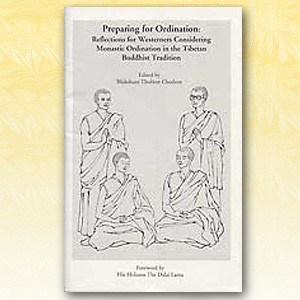For the good of all beings

A series of articles published as Preparing for Ordination, a booklet prepared by Venerable Thubten Chodron and available for free distribution.
Because we understand that the good of all beings is the result of positive acts, we need to know how to act positively. To learn this, there must be teachings. These teachings can only be useful and accessible if they are kept alive by people who practice them, who carry on the tradition, who comprehend and integrate their meaning, thus being able to hand them down to others. To do this, there must be a foundation; there must be the sangha (monastic community). This sangha needs a place to live—it cannot just dwell somewhere in space. It needs to be organized, and this organization is the monastery.
The sangha is not comprised of ordinary people, but of people who practice, experience, and realize the Dharma. The immaterial Dharma is given into a receptacle, the sangha, which keeps it alive. If all of these conditions are brought together, the Dharma remains alive, authentic, and people can then take advantage of the teachings, practice them, and eventually hand them on to others. In this way the good of beings is accomplished. If we go back to square one, we conclude that a monastery must be built.
We could say to ourselves that, in fact, the most important thing is to practice the Dharma. We may begin to practice without paying attention to the organizational structure and think, “I’ve received the teachings from the lama. I can practice on my own and the good of beings will be accomplished through my personal practice.” In the long run, this notion is very limited. If everyone is just concerned with the present, with the relative side of it, without bothering about the continuity of the message, there will be myriad little stars everywhere which will all disappear one day and nothing will remain after us. The energy devoted to the transmission will help the handful of people around the transmission source, but eventually the message will disappear, as will those who had access to it, who developed their practice, but couldn’t benefit from a structure. The objective of the sangha is to be a container, and especially, to ensure the transmission.
The sangha’s goal is to think of the distant future. The distant future isn’t now, it’s the centuries to come, the future generations. Organizational structures must be developed in order to be able to convey this immaterial thing, the realization of the Dharma, throughout the ages. The sangha is crucial because it ensures the durability of the Dharma experience: it receives, practices, understands, perfects, and spreads the teachings. It guarantees that this experience will continue for many centuries.
We must acknowledge the universal law which states that happiness and the root of happiness come from positive acts; suffering and the root of suffering come from negative acts; enlightenment is attained by working for the good of all beings; and the qualities of altruism, generosity, benevolence and so forth bring ourselves and all beings to the freedom from suffering which is perfect enlightenment.
Bhikshu Gendun Rinpoche
Born in Tibet, Gendun Rinpoche studied and did retreat for many years before fleeing to India after the Chinese takeover of Tibet. He received the full Kagyu lineage transmission from the Karmapa and did ten years of retreat in Kalimpong, India. In 1975, the Karmapa sent Gendun Rinpoche to establish his European headquarters at Dhagpo Kagyu Ling in France. He lived there for ten years and traveled to teach at other European Dharma centers. He then went to Le Bost, France, where he is now abbot of Kundreul Ling, a monastery and retreat center.
Bhikshu Gendun Rinpoche
Kundreul Ling
Le Bost, B.P. 1
F-63640 Biollet, France
